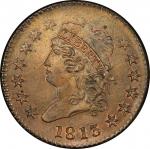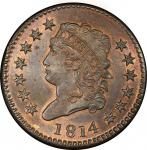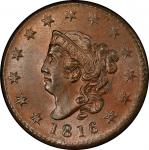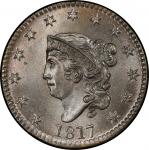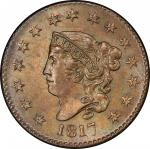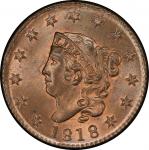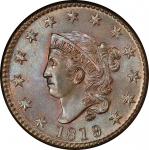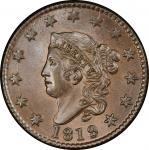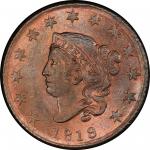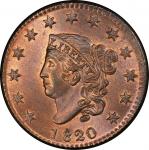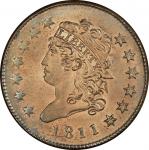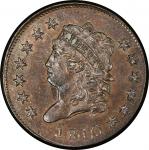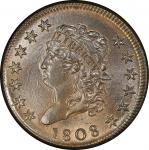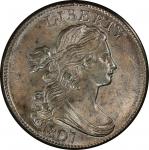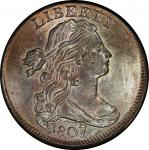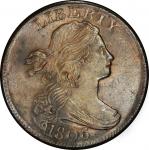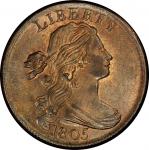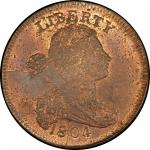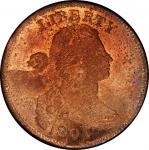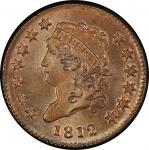Seeing me peering over the bar, he took me by the arms and lifted me over it. Setting me down by the coining press, he asked me if I did not want to make a cent. - George Escol Sellers, recalling his 1812 visit to the Philadelphia Mint, American Machinist, May 4, 1893Cartwheel luster broadly sweeps across both sides, backlighting the mint color that surrounds the obverse design elements and bringing life to the pale blue highlights of the otherwise light brown reverse. The reverse is frosty and appealing, with hints of remaining faded mint color. The obverse shows much more mint color, nicely contrasting with the light brown fields. Some brassy highlights are seen on the obverse device, particularly on the forelock, the top of Libertys head, and the bust truncation. No bad marks are seen on either side, just some inconsequential discoloration below U of UNITED and through ME of AMERICA. A thin scratch crosses the space between D of UNITED and the first S of STATES, and a more hidden one may be seen below the right side of the line below CENT. The die state is advanced, with clash marks evident within the right side of the wreath. The obverse has been lapped, leaving only the most subtle evidence of clashing below the bust, and vertical lapping lines are seen through ITED. Breen describes this as his Die State IV.When this coin reappeared on the market in 1992, having not sold publicly since 1959, it remained as beautiful as when last seen decades before. An arguably more interesting story is told by another "once bright cent" of this date that disappeared for decades before being revealed as "thickly coated with the green copper oxide." The coin had been personally struck by George Escol Sellers, a grandson of Charles Willson Peale who lived in the neighborhood of the First Mint and was kin to many who worked there. One day, Sellers stood in the alley behind the Mint "on tip-toe with my nose resting on the iron bar placed across the open window of the coining room to keep out intruders, watching the men swing levers of the fly press." Upon being spotted, young Sellers was lifted over the bar by Coiner Adam Eckfeldt, who handed him a blank planchet, "showed me how to drop it in, and where to place my hand to catch it as it came out." Sellers caught the brand new red cent, but dropped it "because it was hot and I feared it would burn me." Eckfeldt told him that when he figured out why it was hot, he could spend it on candy, but instead Sellers lost it under some stone steps just days later. Years passed, Sellers returned to the spot with a crowbar, and he recovered the cent hed lost as a boy. "It bore the date 1812, evidence that I was only about four years of age when the picture of its coinage, loss, and other incidents were so indelibly impressed on the storehouse of my brain."While Sellers favorite coin from childhood would probably now be condemned as environmentally damaged, this piece remains one of the finest survivors of this date or variety. A red Mint State specimen has been at the British Museum since 1863 and will remain there eternally. The Reynolds specimen from these dies was graded MS-64 BN (PCGS), and the Varner-McHenry coin listed atop the Bland census has been graded both MS-65 BN and MS-65 RB by PCGS. The only 1812 cent graded higher is the one in the previous lot.

